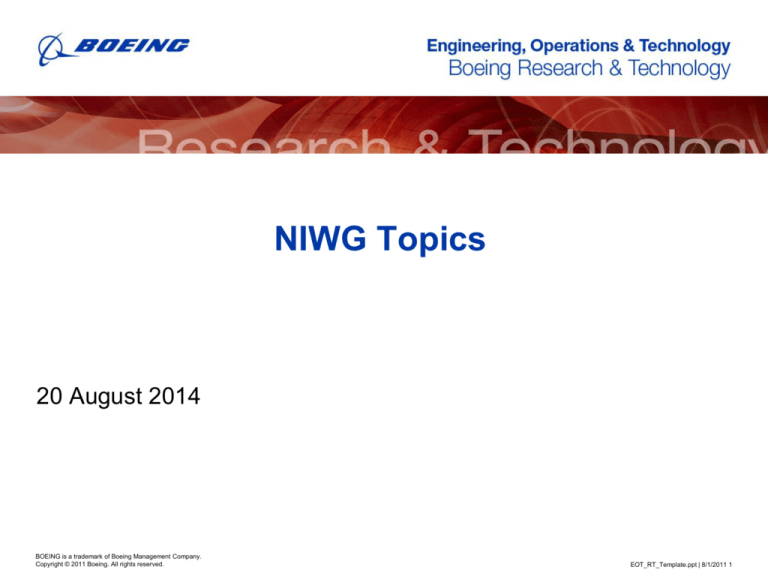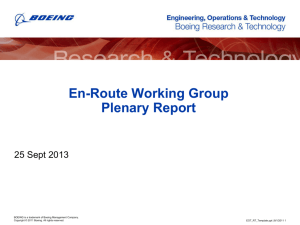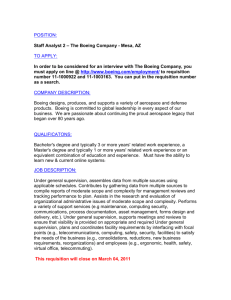
NIWG Topics
20 August 2014
BOEING is a trademark of Boeing Management Company.
Copyright © 2011 Boeing. All rights reserved.
EOT_RT_Template.ppt | 8/1/2011 1
NIWG Topics
Engineering, Operations & Technology | Boeing Research & Technology
The NAC has created 4 NexGen Implementation Working
Groups to cover near-term implementation activities
– Data Comm is one of the four groups DCL (S1P1) and En-Route (S1P2)
– Tackling some of the issues we’ve identified but struggled with in DCIT
(e.g. Data Recording Rule)
– Good compliment to DCIT: high-level direction rather than technical work
NIWG topics to brief-out today
Use of non-VDL-2 sub-networks in en-route airspace (e.g. POA)
FANS-1/A+
En-Route Risk Mitigation (trials, test plan, etc.)
B737 airway/airway status
Copyright © 2011 Boeing. All rights reserved.
NIWG and POA (non-VDL-2 use in en-route)
Engineering, Operations & Technology | Boeing Research & Technology
NIWG recommendations
– NIWG recommends that the FAA allow operators to use FANS 1/A over media
other than VDL-2, including POA, in domestic US en route airspace.
– If any media other than VDL-2 is used, the operator would be responsible for
contracting with an air-ground communications provider and complying with
any corresponding communications performance requirements.
In order to assess their ability to fulfill this responsibility,
operators need the underlying performance requirements
– Harris, Chris Collings, will provide a performance requirements briefing at
DCIT-36, covering non-VDL-2 media
Copyright © 2011 Boeing. All rights reserved.
NIWG FANS-1/A+
Engineering, Operations & Technology | Boeing Research & Technology
FANS-1/A+ Description
FANS-1/A+ is a mitigation means for messages which are delayed in the air/ground data
communications network, and then delivered to the flight deck leading to the potential for a
superseded clearance being acted on by the aircrew. FANS-1/A+ refers to a function which either
discards the message with a rejection notice to the ground, or annunciates the late time of delivery to
the aircrew so that they do not act on the message without contacting air traffic control.
NIWG Recommendation
The FAA does not require FANS-1/A+ for Tower Services. The FAA does require FANS-1/A+ for enroute services, in order to mitigate the latent message hazard.
However, some aircraft are unable to install FANS-1/A+, at least not without such a high cost that the
business case for equipping that aircraft no longer closes.
For these aircraft, FAA Flight Standards has advised the NIWG that they will consider alternate
mitigation means for the latent message hazard for those operators that have identified an alternate
mitigation means and that apply to utilize that mitigation means.
Next Steps
As with POA, in order to assess their ability to find an alternate mitigation means, operators need the
underlying requirements that they need to meet.
Operators have requested these requirements from the FAA Program
Copyright © 2011 Boeing. All rights reserved.
NIWG Recommendations
(En-Route Risk Mitigation)
Engineering, Operations & Technology | Boeing Research & Technology
Historical context
The DCL (S1P1) Phase of the FAA’s Data Comm Program has benefited from a comprehensive inservice trials program. This trials program, conducted for multiple years at Memphis and Newark
airports and supported by FedEx, UPS, and United Airlines, along with the Air Traffic Control facilities
serving those airports, has resulted in extensive changes to the original designs for DCL Services.
Observations and changes arising from these trials have been significant enough that it is widely
accepted among participants, and the DCIT that guided the implementation, conduct, and lesson
captures from these trials that the operational system would have failed upon introduction without
them.
En-route recommendations
Industry and the FAA collectively believe that, while such trials would benefit the En-Route (S1P2)
Phase of the FAA’s Data Comm Program, they are not required for the successful deployment of EnRoute Services. En-route trials of a similar fidelity to surface trials are not practical and there are
alternative risk mitigations.
The NIWG recommends that as long as the collaborative and consultative requirements capture and
issue resolution methodology is carried forward into en-route systems and procedure development,
comprehensive trials are not necessary for en-route (S1P2). On establishment of S1P2 baseline
NIWG recommends that the S1P2 test program, including potential flight evaluations and capabilities
such as the Lockheed Martin S1P2 Prototype, be brought into DCIT for consultative review in order to
allow gaps to be identified and resolved.
DCIT has established actions to begin receiving and reviewing this material at DCIT-36 in October
2014. DCIT will use this material to conduct a risk assessment that can be used to assess the test
program and identify such gaps. Potential mitigation means the DCIT will explore during this exercise
include pre-release operational testing, and will cover the period from the current developmental
activities up to the final operational tests prior to S1P2 IOC.
Copyright © 2011 Boeing. All rights reserved.
Engineering, Operations & Technology | Boeing Research & Technology
B737 Airway-to-Airway
Copyright © 2011 Boeing. All rights reserved.
U11 Status
Engineering, Operations & Technology | Boeing Research & Technology
The minimum B737 FMC version for the FAA Program,
including DCL, is U11
U11 is scheduled for a May 2015 Service Bulletin
B737 operators can achieve activation, approval, and
training for operations out of applicable DCL sites
Copyright © 2011 Boeing. All rights reserved.
1. Airway-Airway intersections on B737
Engineering, Operations & Technology | Boeing Research & Technology
There are 2 known issues with Airway/Airway intersections
1. The GE FMC does not allow Airway to Airway construct, without a published waypoint at
the intersection:
– SUZIE.J80.J196.BCE
This feature is not specific to datalink, it is core to the FMC’s route processing
B737 operators know how to work with it
Changing this processing would be a new and complex feature which will take time to introduce
Copyright © 2011 Boeing. All rights reserved.
2. Airway-Airway Intersections
Engineering, Operations & Technology | Boeing Research & Technology
The GE FMC does not insert a DISCON on route review pages
where the uplinked airways should appear
this makes it possible for the crew to overlook the fact that data is
missing, even though “partial clearance loaded” is displayed
See pictures on following slide
This is something which can and should be fixed quickly
Copyright © 2011 Boeing. All rights reserved.
Engineering, Operations & Technology | Boeing Research & Technology
Back-up
Copyright © 2011 Boeing. All rights reserved.
No DISCON displayed
Engineering, Operations & Technology | Boeing Research & Technology
(80) : Cleared [routeclr]
orig airport(): KEWR
dest airport(): KSFO
arr procname():
ARR,MOD4,OAL
route info(): 6
(pub): GYNTS
(pub): SUZIE
(airway): J80
(airway): J100
(pub): BCE
(pub): OAL
Copyright © 2011 Boeing. All rights reserved.
J80 and
J100 do
not load.
NO
DISCONS
displayed
Intersection
point
“SAKES” is
not
uplinked
What we’re trying to achieve in DCIT
Engineering, Operations & Technology | Boeing Research & Technology
Data Comm PM understands and supports the utility of trials
– To date there’s been no clear business case for the trials
NAC NIWG requested DCIT input on the business case
Fielded the work at 6 August ERWG
Previous DCIT material not specific enough to justify trials
– Consolidated specific risk items from our previous material into a table
ERWG to review for finalization between now and DCIT-35
– Risk areas
– Means of reducing risk (trials and alternate means)
Key need: at least one risk area that
Is sufficient to drive the business case
Can be significantly reduced through trials completed in 2015
– Implemented, flown, and results consolidated by end-cy2015
Copyright © 2011 Boeing. All rights reserved.
DCIT Path
Engineering, Operations & Technology | Boeing Research & Technology
8/8/14: brief NIWG on status
8/15/14: ERWG members provide input to Table
Action: Rob to update table based on inputs
Review any available trials format material that can be provided
Potential Airspace type(s) involved
Potential aircraft and aircrew involved
Potential services and messaging involved
We (ERWG) do not know where to go for this information, so we are operating
on our current assumptions
8/22/14: Discuss and finalize at DCIT-35, with recommendations to
DCP PM and to NIWG
Primary goal: identify at least one risk area sufficient to drive the business case
for limited trials in 2015
No feedback has been received
Copyright © 2011 Boeing. All rights reserved.
DCIT ERWG inputs to NIWG, 8/8/14
Engineering, Operations & Technology | Boeing Research & Technology
To evaluate risk reduction potential for trials, DCIT needs iterative and
consultative dialogue on trials infrastructure and format (# a/c, airspace
size, ATC operational context)
– DCL-style trials may not be necessary to mitigate the risk areas
– Descriptions so far would prevent DCL-style trials in any case
– As trials format is not yet available, ERWG is assuming the following format
– The trials will be implemented, flown, and results consolidated by end-cy2015.
– The trials will be limited in airspace and operational hours.
– The trials will be limited in aircrew, airline, and aircraft type participation.
– The trials will be limited in terms of integration with daily ATC operations
DCIT recommended that NIWG review previous DCIT material
– Especially a/c impact slide, but also back-up material from these slides
– Quantification of the value of DCL trials, in terms of Requirements changes for
production system
– FAA or Harris would need to provide an update to the May 2013 DCIT
presentation on this topic
Copyright © 2011 Boeing. All rights reserved.
Table Review (sample)
Engineering, Operations & Technology | Boeing Research & Technology
Objective
Risk (H/M/L)
2015 trials
Other means
Validate end-to-end connectivity performance including human response
time
Maintain Program from today until en-route IOC
L
No
HITLs or further trials
M
Partial
TOC/IC, NSDA
M
No
Would need operational trials post2015
1.
In-depth scenarios and bench
testing can partially cover
2.
Extensible low-impact trials
help significantly
3.
Large scale trials helpful
L
H (until
better
defined)
No
No
HITLs can solve
In-depth scenarios and bench
testing can also resolve, if scenarios
are comprehensive.
M
Limited
See above
H
Very limited
See above
Route loading while a/c is in flight, rather than on ground for Tower
?
Unknown
How to ensure the uplink will join to what’s in the FMC
(DCL we know from the FPL, TAs we knew from oceanic exit points, en-route
we don’t know)
M
Limited
End-end scenarios.
Bench testing
End-end scenarios.
Bench testing
TOC/IC “CPDLC on/CPDLC off”
TOC/IC (including LO), use of DR1, transfers in/out of domestic, retention of
NDAs with Canada and Oceanic, abnormal tear-downs.
This item includes validation of the architectural design (ATN aborts
translated to FANS-1/A)
Altitudes or speed constraints in route clearance portion (e.g. for cruise
altitude or higher)
SIDs/Transitions
Copyright © 2011 Boeing. All rights reserved.
NIWG Recommendations
Engineering, Operations & Technology | Boeing Research & Technology
Historical context
The DCL (S1P1) Phase of the FAA’s Data Comm Program has benefited from a comprehensive inservice trials program. This trials program, conducted for multiple years at Memphis and Newark
airports and supported by FedEx, UPS, and United Airlines, along with the Air Traffic Control facilities
serving those airports, has resulted in extensive changes to the original designs for DCL Services.
Observations and changes arising from these trials have been significant enough that it is widely
accepted among participants, and the DCIT that guided the implementation, conduct, and lesson
captures from these trials that the operational system would have failed upon introduction without
them.
En-route recommendations
Industry and the FAA collectively believe that, while such trials would benefit the En-Route (S1P2)
Phase of the FAA’s Data Comm Program, they are not required for the successful deployment of EnRoute Services.
En-route trials of a similar fidelity to surface trials are not practical and there are alternative risk
mitigations.
The NIWG recommends that as long as the collaborative and consultative requirements capture and
issue resolution methodology is carried forward into en-route systems and procedure development,
comprehensive trials are not necessary for en-route (S1P2).
On establishment of S1P2 baseline NIWG recommends that the S1P2 test program, including
potential flight evaluations, be brought into DCIT for consultative review in order to allow gaps to be
identified and resolved.
DCIT is conducting a risk assessment that can be used to assess the test program and identify such
gaps.
– Is the table complete in our minds?
Copyright © 2011 Boeing. All rights reserved.
Engineering, Operations & Technology | Boeing Research & Technology
Back-ups to review
Copyright © 2011 Boeing. All rights reserved.
Top-level trials value (1)
Engineering, Operations & Technology | Boeing Research & Technology
Risk reduction for en-route operational deployment
Indispensible to an operationally viable en-route deployment
Simply put, initial DCL operations without the trials would have failed
Both operationally focused design process and flights contributing
Trials provide essential, operationally focused, real-world
Concept validation
System definition and validation with in-field systems and operational staff
Procedure definition and validation with line crews and controllers
Identification of airborne issues that need to be solved
Continuation of trials past requirements freeze is good
Does not imply direct roll-over of new findings to first operations
Identifies and resolves airborne, ground and procedural issues
Prevents start again/stop-again crew participation (reappearance of
previously solved problems during operations)
Copyright © 2011 Boeing. All rights reserved.
Top-level trials value (2)
Engineering, Operations & Technology | Boeing Research & Technology
Validate end-to-end connectivity performance including
human response time.
We already have a lot of data on this but brings in some pilot/controller
workload assessments and pilot acceptability in a live environment
Allows for a first step to work out issues
Very useful to further incentivize airlines. The further out
airlines see the benefits, the longer it will take to equip.
DCIS only has money for 1900 aircraft. It will stop there if not accepted
Benefits-oriented trials are viable and an invaluable bridge for aircraft
equipage
Create, and maintain, Program from launch to IOC
Copyright © 2011 Boeing. All rights reserved.
Summary of by-Service Objectives
Engineering, Operations & Technology | Boeing Research & Technology
Route clearance construction
–
–
–
–
–
–
Route segments not covered by DCL
Intercept Arrivals/Transitions part way down
Altitudes or speed constraints in route clearance portion (e.g. for cruise altitude or higher)?
SIDs/Transitions?
Aircrew and/or AOC requests
Inclusion of Arrivals/Transitions along with Approaches/Transitions
TOC
–
–
–
–
Verify Monitoring Frequency
The SDA concept, a first in the world so high risk, with highest impact if the risk is realized
“CPDLC on/CPDLC off” use
CAL for descending and climbing aircraft?
Copyright © 2011 Boeing. All rights reserved.
2012 PRs by Problem Area
Engineering, Operations & Technology | Boeing Research & Technology
All Problem Reports by Problem Area
Jan 1, 2012 - Dec 31, 2012
1
3
4
6
19
AIR - procedural
AIR - technical
GROUND
20
59
NETWORK
mult
None
TBA
• System and procedures continue to be wrung out in advance of full operations
• Lead-time available for system components to address issues
• Operational momentum and experience maintained
Copyright © 2011 Boeing. All rights reserved.
Sample value captures we have seen in DCL
Engineering, Operations & Technology | Boeing Research & Technology
Arrival/Transition formatting issue
Regular failures would occur in operations, risking all of DCL ops.
Significant potential operational impact to aircraft operator flight planning
Still no complete and agreed solution
24-bit address use
Persistent log-on problems would have occurred, with redesign impact
Unexpected closure of dialogues (SAS issue)
– There is time for aircraft to work the problem before full operations
MD-11 Nav Display
There is time for aircraft to work the problem before operations
Duplicate message handling on the ground
Operational systems would have had redesign impact
What is the value to the program of these and other items?
Copyright © 2011 Boeing. All rights reserved.
Alternatives
Engineering, Operations & Technology | Boeing Research & Technology
In theory, these things could be handled through
– Detailed joint systems design, using targeted operational environments for realistic
operational scenarios
– This is what we have done with DCL, and are now just launching with ER
In reality though, some of the highest value results come from targeted
operational situations
– Involvement of live situations, operational staff and systems, and operational data that
give some of the most critical results
– It is extremely hard to fill this hole with paper-mill meetings
– Operational specifics get lost
– Operational dynamics get lost
– Lotsa smart people used to fixing the things that cause big problems
– Has this approach ever succeeded with datalink?
Very simply:
– Why did it take so long to realize that we should not use um73?
– Trials moved op sched to the right due to the trials
– Without the trials, op deployment probably would have simply failed
– We avoided the farthest right movement (termination)
Copyright © 2011 Boeing. All rights reserved.
Cost of insufficient validation
Engineering, Operations & Technology | Boeing Research & Technology
B737NG
B757/767
MD80/90
A320 family
B777
A300
MD11
A330
B747-400
ER-190
B787
ER-135
1017
944
361
252
183
123
104
59
73
68
48
18
31%
29%
11%
8%
6%
4%
3%
2%
2%
2%
1%
1%
2019 projections from Harris
Had we not done DCL trials, on the order of
–
–
–
–
31% failed DCLs (B737)
29% failed DCLs (B757/B767)
Various other aircraft, with corresponding fail rate
Expensive and time consuming rework to recover
Bottom line: without DCL-style trials, expect Program risk
Copyright © 2011 Boeing. All rights reserved.







